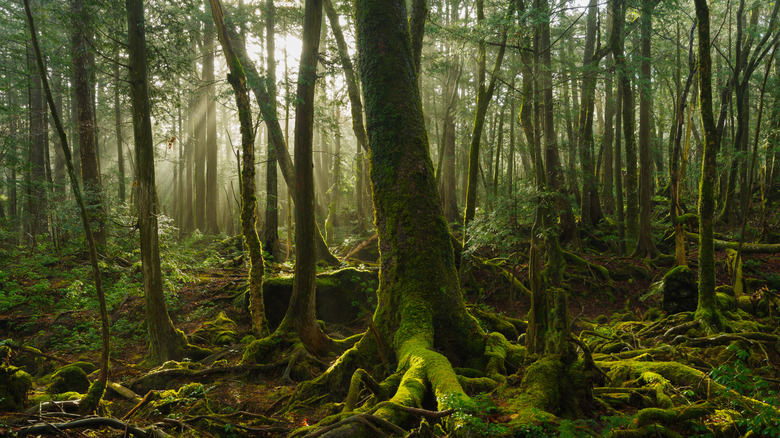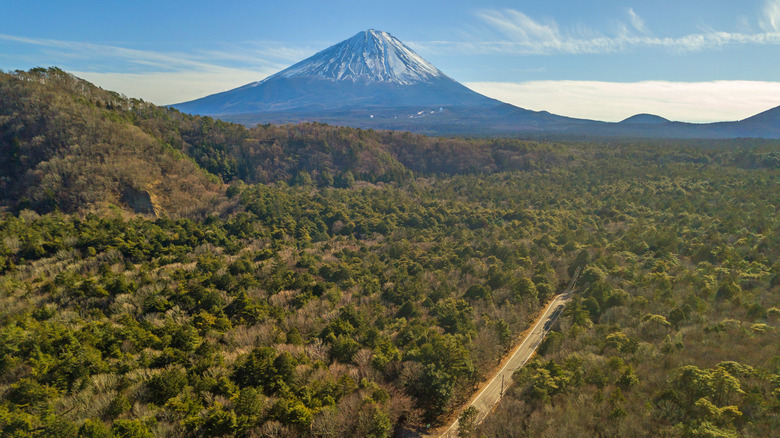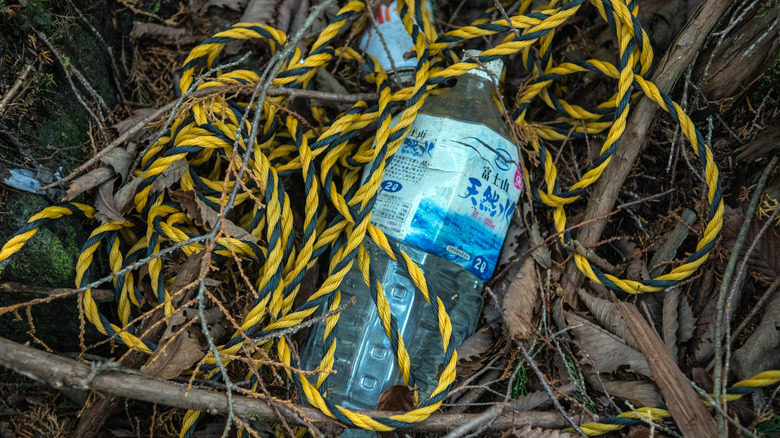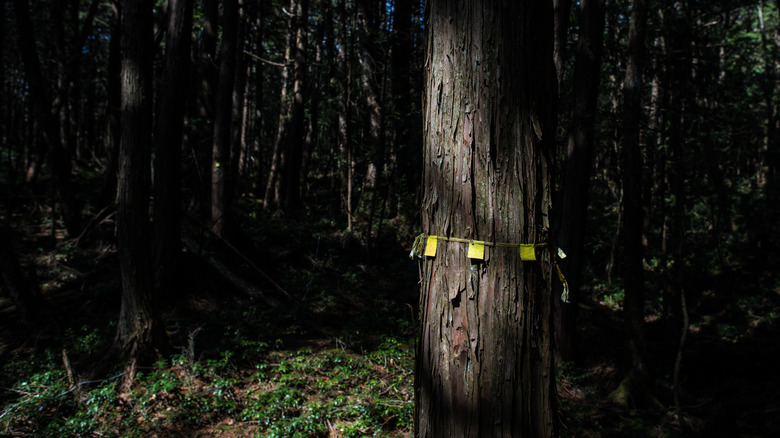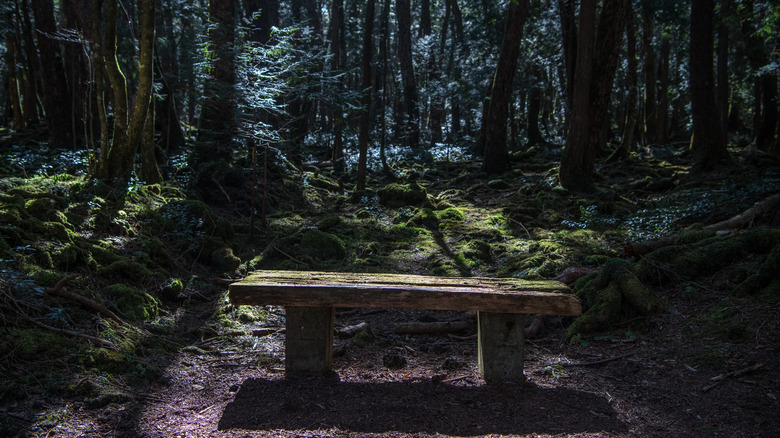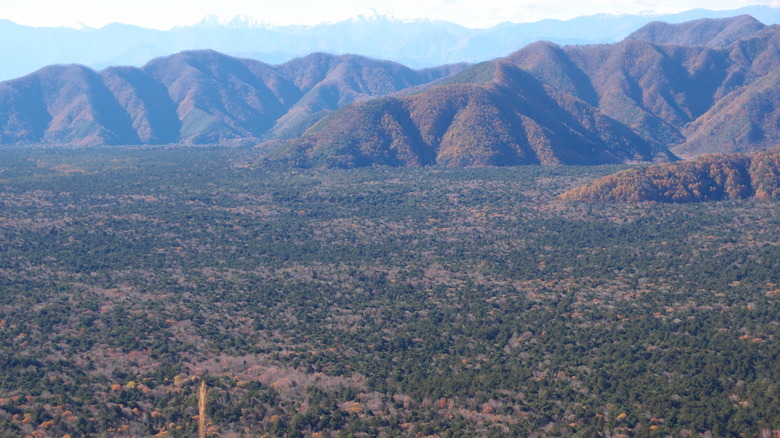The Disturbing Origins Of Japan's Suicide Forest
When folks think of Japan, thoughts might sway to one of two stereotypes: Edo-era medieval kimono-wearing geisha and sword-wielding samurai, or modern anime-and-neon glitz for the otaku. In a way, such dichotomies are true. Head towards the south of Japan's main island, Honshu, and you'll find the grand, gorgeous temples of the UNESCO World Heritage-laden old capital, Kyoto. Head to the back alleys of Akihabara in Tokyo and you'll find a swarm of maid cafes and tiny shops full of paintable action figures. But beyond such obvious offerings rests deeper, darker countryside spots. Like blackened blots on the Japanese psyche, these are places of legend, the supernatural, and even death. Such is the case with Aokigahara, dubbed "Suicide Forest."
From a top-down view, Aokigahara might look like any other sprawling, dense forest you'd find across the globe. A tangle of mossy roots blankets the forest floor like crooked, creeping fingers. Light penetrates the canopy here and there to illuminate wet, dark spots unaccustomed to the sun. The forest is oddly silent, as though holding its breath and hoping hikers step off designated trails. In the present day, Aokigahara's disturbing air comes from its reputation as much as its appearance. As Vice describes, the forest is Japan's most common destination for people seeking to commit suicide. They make the pilgrimage to the foothills of Mt. Fuji and vanish into Aokigahara's trees, leaving behind empty bottles, rope, and their own hanged bodies (via the Daily Mail).
If you or anyone you know is having suicidal thoughts, please call the National Suicide Prevention Lifeline by dialing 988 or by calling 1-800-273-TALK (8255).
In the foothills of a god
In a way, it makes sense that Aokigahara — also called the "Sea of Trees" — resides in sight of Mt. Fuji. The significance of Mt. Fuji to Japan can't be understated, as Japan's Public Relations Office describes. At times revered as the deity Asama-no-Okami, Mt. Fuji — an active volcano — represents a gateway to the heavens and a union of the elements. It's a "living god," as renowned 17th-century Japanese poet Matsuo Basho called it, a place where fire and snow clash in "eternal combat," per Smithsonian Magazine. Professor Cathy Davidson said of the mountain, "I do not know a single person who just climbs Mount Fuji. The weight of the mountain's art, philosophy and history climb the path alongside you. Fuji is the soul of Japan." Fuji can be seen for hundreds of kilometers in any direction, like a guidepost for the living.
When Mt. Fuji erupted in 864 C.E., its pyroclastic flow consumed 12 square miles of surrounding land, per The New York Times. As National Geographic explains, lava hardened into place and became the soil on which Suicide Forest grew; this explains why the forest is so uneven, cave-ridden, and difficult to traverse. As early as 27 B.C.E., Emperor Suijin tried to appease Mt. Fuji's anger by building the region's first shrine, which spawned over 1,300 more shrines in turn (per Fujisanhongu Sengentaisha). And in the present, Fuji continues to accept sacrifices in the form of people's own lives.
If you or anyone you know is having suicidal thoughts, please call the National Suicide Prevention Lifeline by dialing 988 or by calling 1-800-273-TALK (8255).
To not die alone
Japan is well-known for its high suicide rates. Statista reports that rates have gone down in the last decade but saw an uptick in the middle of the COVID-19 pandemic to 16.8 suicides per 100,000 people. In 2014, as the BBC reported, that amounted to a shocking 25,000 people, most of whom were men. Residents of metropolises like Tokyo are more than familiar with "jinshin jiko" announcements — public transportation delays due to "human body accidents," as Japan Today cites; this is a polite euphemism that means that someone jumped in front of an oncoming train.
As sites like All That's Interesting say, about 100 people per year choose to take their lives by heading to Aokigahara. Visitors come across discarded clothes, remnants of campsites, empty bottles once filled with bleach, and nooses hanging from trees, as National Geographic describes. Signs at the forest entrance warn against taking one's own life and say that "life is a precious gift" from one's parents. "Quietly think once more about your parents, siblings or children," the signs continue (per CNN). "Please don't suffer alone, and first reach out." But to those who take their own life, psychiatrist Yoshitomo Takahashi believes the forest itself is a way to reach out — to join others who chose similarly and not die alone.
If you or anyone you know is having suicidal thoughts, please call the National Suicide Prevention Lifeline by dialing 988 or by calling 1-800-273-TALK (8255).
Marked for, and by, death
How, the reader might be wondering, did Aokigahara become such a suicide hotspot? In the present day, the forest's reputation is self-sustaining — it's popular because it's been popular. Its roots, though, draw from fact and fiction, romantic notions and spiritual significance, and media hype and folklore.
Emadion says that reports of suicides in Aokigahara date back to the 1950s. "Tower of Waves" (1960), a mystery novel by Seicho Matsumoto, sensationalized the forest and jumpstarted the public's fascination with it. As National Geographic puts it, the book features a "beautiful, love-torn heroine who commits suicide there." In 1993, Wataru Tsurumi published the disturbing "The Complete Manual of Suicide," a book that described Aokigahara as the perfect place to die — within its trees and in proximity to Mt. Fuji — and cataloged all the best ways to do so. Nowadays, bodies are still found with Tsurumi's book on them, per Seek Japan.
As The Horror Zine says, Aokigahara grew to be the world's second-highest suicide hotspot by 2003, after the Golden Gate Bridge. Officials stopped releasing official numbers, so the current number of 100 suicides per year represents a best estimate. This is especially true because bodies decay quickly in the forest. The last official count came in 2010, as The Japan Times says, when 54 bodies were found out of 247 suicide attempts. Because hanging is the most common method of suicide, officials mark trees where people have died (pictured above).
If you or anyone you know is having suicidal thoughts, please call the National Suicide Prevention Lifeline by dialing 988 or by calling 1-800-273-TALK (8255).
Discarded by family
The origins of Aokigahara as a suicide hotspot may go way, way back before the 1960s and questionably ethical "how to commit suicide" nonfiction books. There's no way to verify the truth of such earlier origins, however, because they delve into the realm of folklore. That being said, there's a precedent in the present for their possible truth.
As the tales go, folks at various points in ancient and medieval Japan practiced "ubasute," the act of depositing an elderly, burdensome family member at some remote place and leaving them to die. Aokigahara is one such location. As The New Zealand Herald describes, this might have happened because the elderly person was ill or too infirmed to contribute to a household — such a case happened as recently as 2011. As History & Policy states, an elderly family member may have voluntarily offered to die in this way, especially in times of famine or drought. Such practices have been a part of Japanese folklore for centuries and depicted in modern media as early as the 1925 black and white short film, "Kyoiku senga: Ubasute yama," per IMDb.
Needless to say, for reasons such as these, Aokigahara is a hotbed for stores of yurei, tormented spirits of the dead. As Twinkle Viral cite, they permeate the forest and give it its eerie, unsettling feeling. They seek to lure visitors off trails and to their deaths, whether they entered the forest intending to commit suicide or not.
If you or anyone you know is having suicidal thoughts, please call the National Suicide Prevention Lifeline by dialing 988 or by calling 1-800-273-TALK (8255).
Prevention and aid
Currently, the Japanese government has implemented measures meant to curb the number of suicides in Aokigahara. Aside from the aforementioned pleading signs at the forest's entryway, officials have blocked off certain areas and raised guardrails on bridges to make it more difficult jump off. As Japan Inside continues, volunteers searching for bodies tie tape to trees to mark their path. Sometimes visitors do the same, especially if they're not sure if they want to end their life and need to easily backtrack out of the forest. Camping is frowned on and likely to grab the attention of park officials because it's believed that people considering suicide often stay overnight to mull it over. And yes, there are dedicated cleanup teams that constantly prowl Aokigahara and remove bodies, as SuicideCleanup.com says.
But even amidst such grim and horrific facts, there's hope. 77-year-old Yukio Shige may have found the best answer to saving the lives of those who venture into Aokigahara with suicidal intentions, an answer so simple and human that it might go unconsidered. As the Union of Catholic Asian News says, Shige is a former police officer and head of a suicide prevention NGO. He literally wanders Aokigahara saying "hello" to people — that's it. That tiny gesture of reaching out, perhaps followed up with some basic conversation, has been enough for him to prevent the suicides of 721 people as of February 3, 2022. Such a lesson in basic kindness bears noting by everyone.
If you or anyone you know is having suicidal thoughts, please call the National Suicide Prevention Lifeline by dialing 988 or by calling 1-800-273-TALK (8255).
